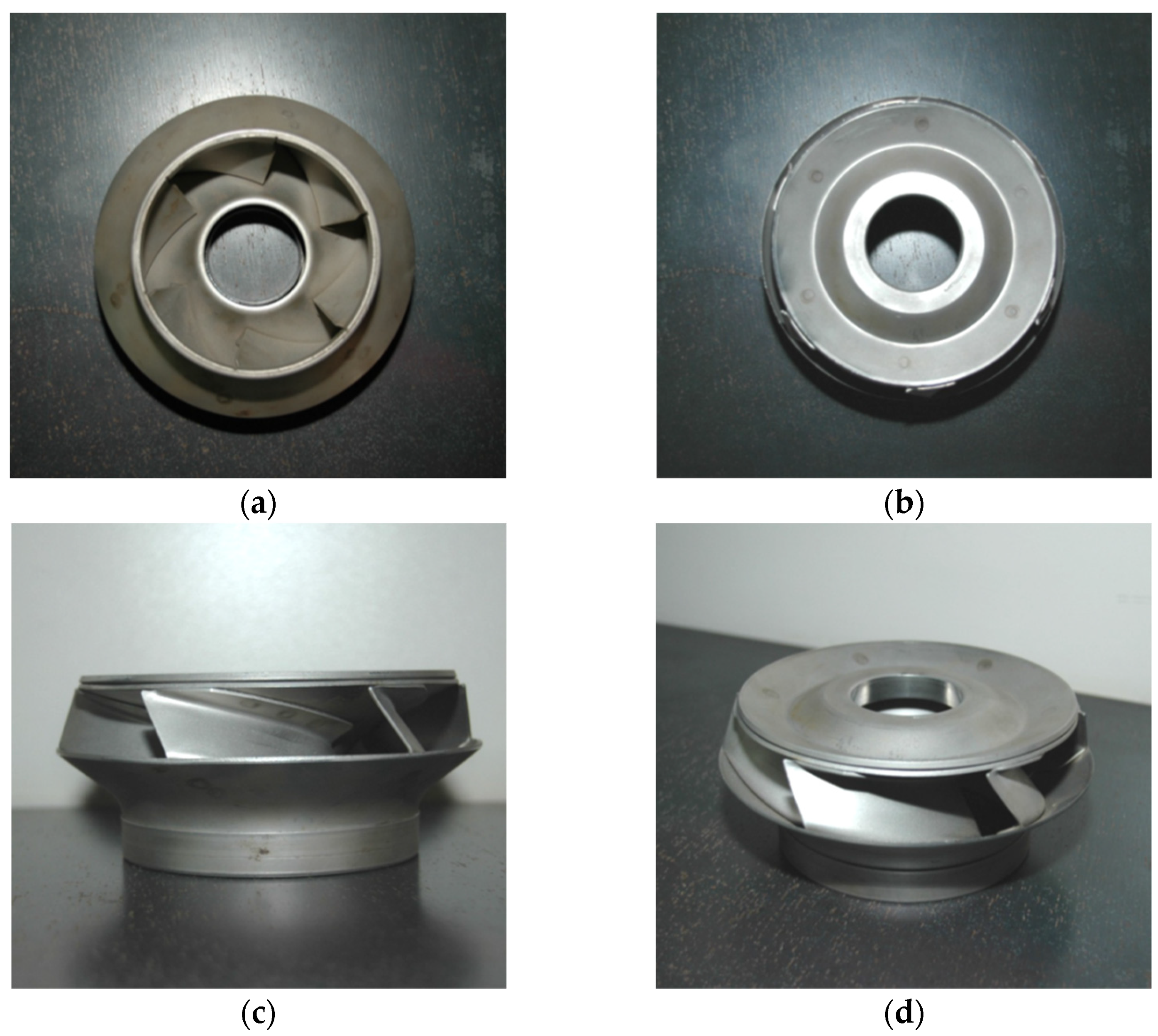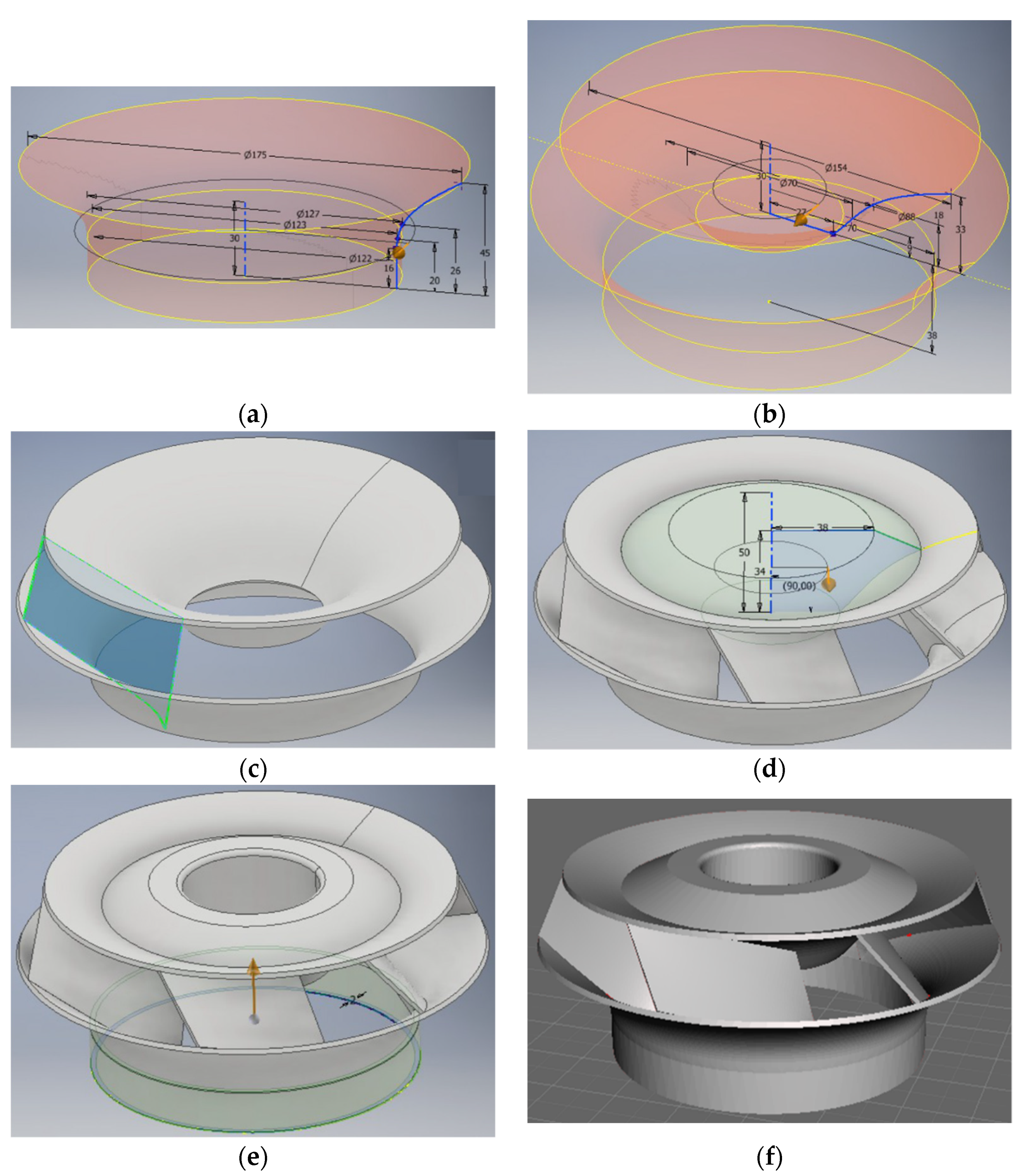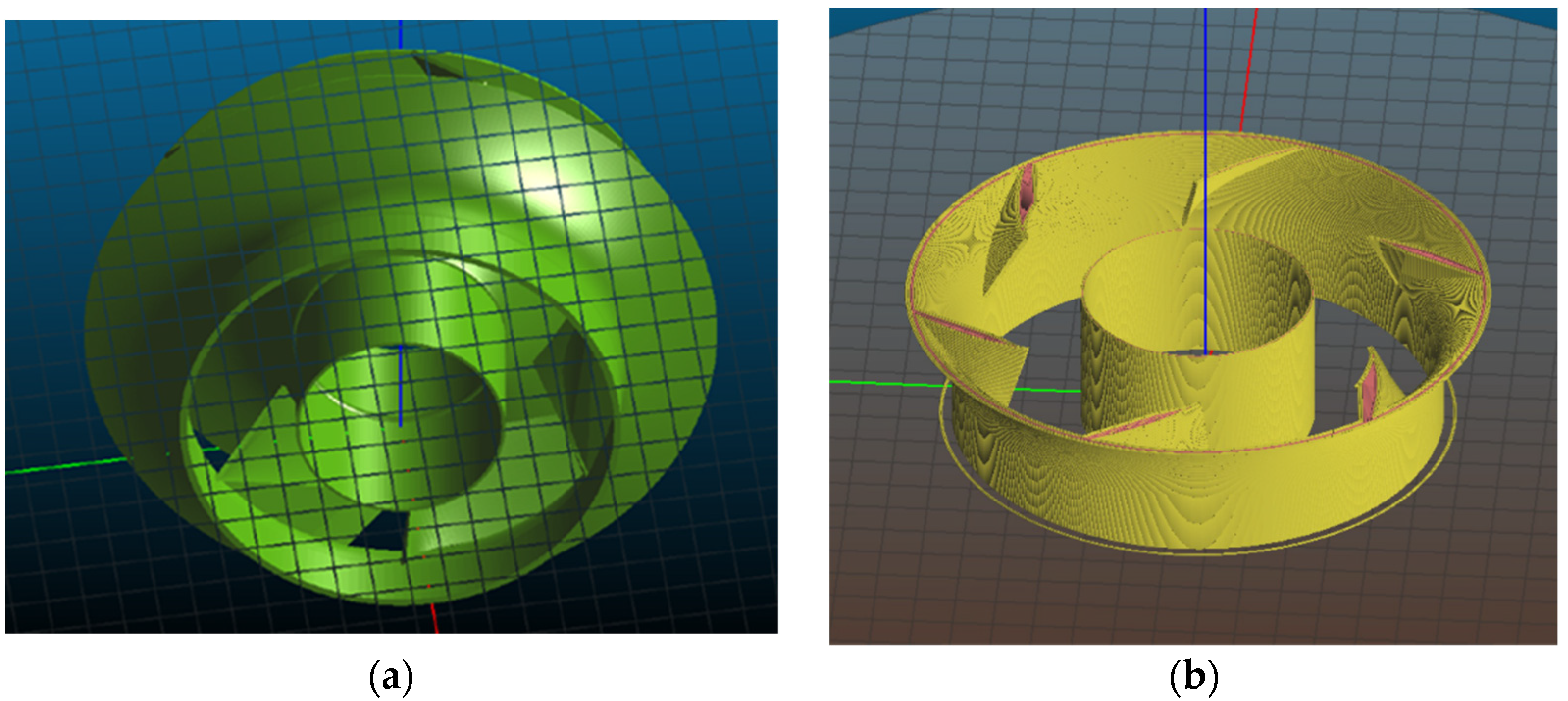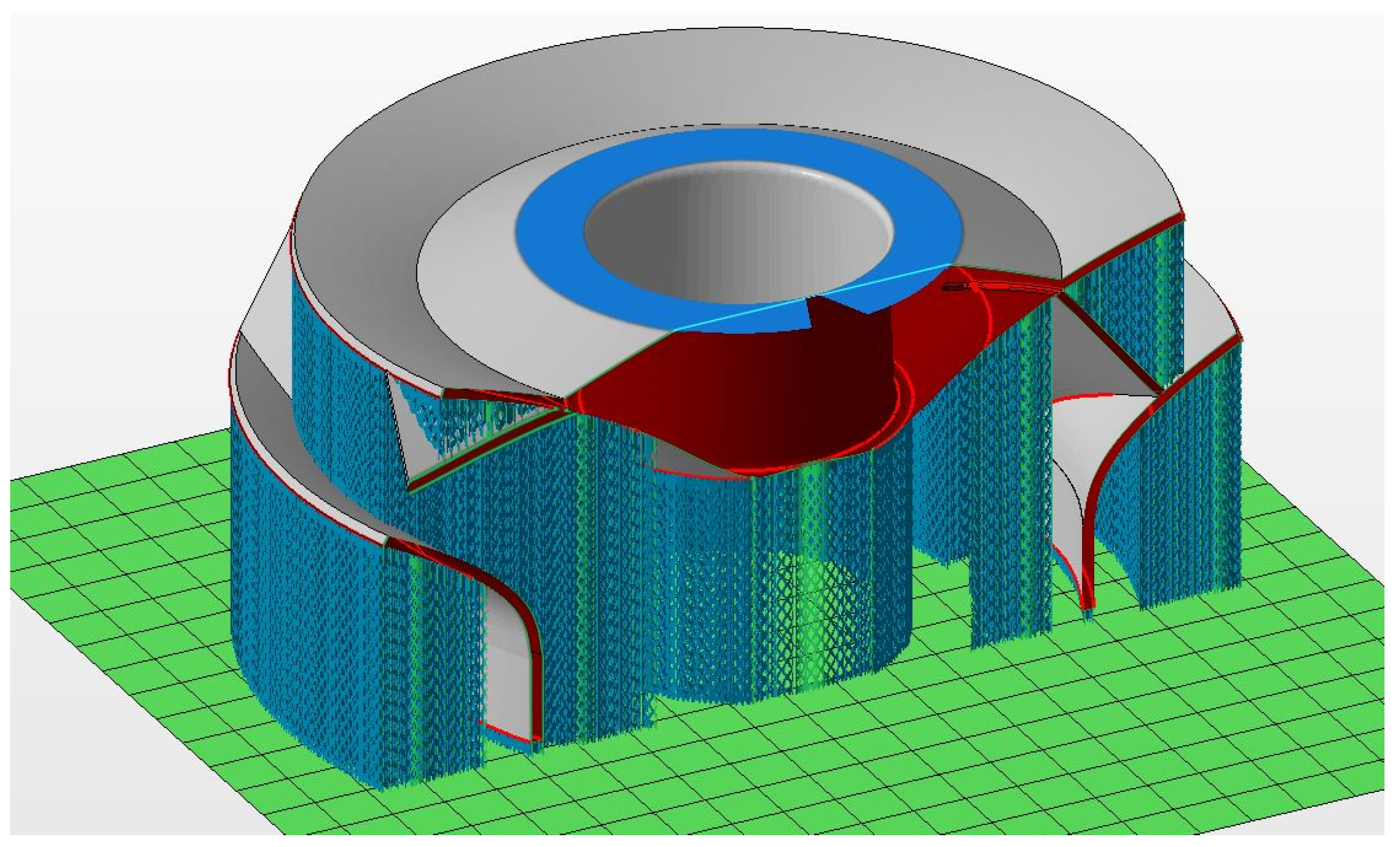Re-Engineering of an Impeller for Submersible Electric Pump to Be Produced by Selective Laser Melting
Abstract
:1. Introduction
2. Materials and Methods
- The first activity concerned the reproduction of a 3D model of the chosen submersible electric pump impeller using reverse engineering techniques and creating the model within the Autodesk Inventor environment;
- The second step was aimed at evaluating the mechanical response of the proposed materials and models to be printed with additive manufacturing techniques by means of a finite element analysis through the Autodesk Nastran-IN-CAD environment; this phase allowed predicting the applicability of the 3D printed functional model;
- Finally, both the concept and the functional prototypes were printed by using the fused deposition modelling and the selective laser melting techniques, respectively. In particular, the concept prototype is used to assess the feasibility of the re-engineered impeller model and to make the designer able to carry out the appropriate changes before the final printing of the functional model in SLM, which should be used for the final application.
2.1. 3D Impeller Model Reconstruction
- Modelling of the lower flared part;
- Modelling of the upper flared part;
- Impeller blade modelling;
- Circular series of the impeller blade to obtain the other five blades;
- Modelling of the reinforcement solid for connection to the axis;
- Modelling of the lower wear ring.
2.2. Finite Element Analysis
- AISI 304 stainless steel sheet work-hardened by plastic deformation through molding;
- PET for the 3D printing of the concept model through fused deposition modelling (FDM);
- AISI 316L stainless steel for the 3D printing of the functional model through selective laser melting (SLM).
2.3. 3D Printing
3. Results and Discussion
3.1. Finite Element Analysis
3.2. 3D Printing
4. Conclusions
Author Contributions
Funding
Institutional Review Board Statement
Informed Consent Statement
Data Availability Statement
Acknowledgments
Conflicts of Interest
References
- Kosky, P.; Balmer, R.; Keat, W.; Wise, G. Manufacturing Engineering. In Exploring Engineering; Elsevier: Amsterdam, The Netherlands, 2021; pp. 259–291. [Google Scholar]
- Zheng, J.; Zheng, W.; Chen, A.; Yao, J.; Ren, Y.; Zhou, C.; Wu, J.; Ling, W.; Bai, B.; Wang, W.; et al. Sustainability of unconventional machining industry considering impact factors and reduction methods of energy consumption: A review and analysis. Sci. Total Environ. 2020, 722, 137897. [Google Scholar] [CrossRef]
- Ion, J.C. Evolution of Laser Material Processing. In Laser Processing of Engineering Materials; Elsevier: Amsterdam, The Netherlands, 2005; pp. 12–40. [Google Scholar]
- Bhowmick, S.; Basu, J.; Majumdar, G.; Bandyopadhyay, A. Experimental study of plasma arc cutting of AISI 304 stainless steel. Mater. Today Proc. 2018, 5, 4541–4550. [Google Scholar] [CrossRef]
- Huang, Z.; Li, G.; Tian, S.; Song, X.; Sheng, M.; Shah, S. Theoretical Basis of Abrasive Jet. In Abrasive Water Jet Perforation and Multi-Stage Fracturing; Elsevier: Amsterdam, The Netherlands, 2018; pp. 1–62. [Google Scholar]
- Perumal, A.; Kailasanathan, C.; Stalin, B.; Rajkumar, P.R.; Gangadharan, T.; Venkatesan, G. Evaluation of EDM process parameters on titanium alloy through Taguchi approach. Mater. Today Proc. 2020. [Google Scholar] [CrossRef]
- Ghaffar, S.H.; Corker, J.; Fan, M. Additive manufacturing technology and its implementation in construction as an eco-innovative solution. Autom. Constr. 2018, 93, 1–11. [Google Scholar] [CrossRef]
- Pawar, S.S.; Bera, T.C.; Sangwan, K.S. Modelling of Energy Consumption for Milling of Circular Geometry. Procedia CIRP 2021, 98, 470–475. [Google Scholar] [CrossRef]
- Scharf, S.; Sander, B.; Kujath, M.; Richter, H.; Riedel, E.; Stein, H.; Tom Felde, J. FOUNDRY 4.0: An innovative technology for sustainable and flexible process design in foundries. Procedia CIRP 2021, 98, 73–78. [Google Scholar] [CrossRef]
- Kruth, J.P.; Leu, M.C.; Nakagawa, T. Progress in additive manufacturing and rapid prototyping. CIRP Ann. Manuf. Technol. 1998. [Google Scholar] [CrossRef]
- Molitch-Hou, M. Overview of additive manufacturing process. In Additive Manufacturing: Materials, Processes, Quantifications and Applications; Elsevier: Amsterdam, The Netherlands, 2018; pp. 1–38. ISBN 9780128121559. [Google Scholar]
- Tagliaferri, V.; Trovalusci, F.; Guarino, S.; Venettacci, S. Environmental and economic analysis of FDM, SLS and MJF additive manufacturing technologies. Materials 2019, 12, 4161. [Google Scholar] [CrossRef] [Green Version]
- Guarino, S.; Ponticelli, G.S.; Venettacci, S. Environmental assessment of Selective Laser Melting compared with Laser Cutting of 316L stainless steel: A case study for flat washers’ production. CIRP J. Manuf. Sci. Technol. 2020. [Google Scholar] [CrossRef]
- Hofer, A.-K.; Kraleva, I.; Bermejo, R. Additive manufacturing of highly textured alumina ceramics. Open Ceram. 2021, 5, 100085. [Google Scholar] [CrossRef]
- McCarthy, E.; Brabazon, D. Additive Manufacturing for Sustainability of Composite Materials Production. In Reference Module in Materials Science and Materials Engineering; Elsevier: Amsterdam, The Netherlands, 2021. [Google Scholar]
- Fernandes, R.R.; Tamijani, A.Y.; Al-Haik, M. Mechanical characterization of additively manufactured fiber-reinforced composites. Aerosp. Sci. Technol. 2021, 113, 106653. [Google Scholar] [CrossRef]
- Mehrpouya, M.; Vosooghnia, A.; Dehghanghadikolaei, A.; Fotovvati, B. The benefits of additive manufacturing for sustainable design and production. In Sustainable Manufacturing; Elsevier: Amsterdam, The Netherlands, 2021; pp. 29–59. [Google Scholar]
- Druzgalski, C.L.; Ashby, A.; Guss, G.; King, W.E.; Roehling, T.T.; Matthews, M.J. Process optimization of complex geometries using feed forward control for laser powder bed fusion additive manufacturing. Addit. Manuf. 2020, 34, 101169. [Google Scholar] [CrossRef]
- Barletta, M.; Gisario, A.; Mehrpouya, M. 4D printing of shape memory polylactic acid (PLA) components: Investigating the role of the operational parameters in fused deposition modelling (FDM). J. Manuf. Process. 2021, 61, 473–480. [Google Scholar] [CrossRef]
- Mehrpouya, M.; Gisario, A.; Nematollahi, M.; Rahimzadeh, A.; Baghbaderani, K.S.; Elahinia, M. The prediction model for additively manufacturing of NiTiHf high-temperature shape memory alloy. Mater. Today Commun. 2021, 26, 102022. [Google Scholar] [CrossRef]
- Rinaldi, M.; Caterino, M.; Manco, P.; Fera, M.; Macchiaroli, R. The impact of Additive Manufacturing on Supply Chain design: A simulation study. Procedia Comput. Sci. 2021, 180, 446–455. [Google Scholar] [CrossRef]
- Ford, S.; Despeisse, M. Additive manufacturing and sustainability: An exploratory study of the advantages and challenges. J. Clean. Prod. 2016, 137, 1573–1587. [Google Scholar] [CrossRef]
- Mukherjee, T.; DebRoy, T. Mitigation of lack of fusion defects in powder bed fusion additive manufacturing. J. Manuf. Process. 2018, 36, 442–449. [Google Scholar] [CrossRef]
- Moran, T.P.; Warner, D.H.; Phan, N. Scan-by-scan part-scale thermal modelling for defect prediction in metal additive manufacturing. Addit. Manuf. 2021, 37, 101667. [Google Scholar] [CrossRef]
- Durgashyam, K.; Indra Reddy, M.; Balakrishna, A.; Satyanarayana, K. Experimental investigation on mechanical properties of PETG material processed by fused deposition modeling method. Mater. Today Proc. 2019, 18, 2052–2059. [Google Scholar] [CrossRef]
- Yan, C.; Shi, Y.; Li, Z.; Wen, S.; Wei, Q. Typical applications of selective laser sintering technology. In Selective Laser Sintering Additive Manufacturing Technology; Elsevier: Amsterdam, The Netherlands, 2021; pp. 877–936. [Google Scholar]
- Song, B.; Wen, S.; Yan, C.; Wei, Q.; Shi, Y. Preparation and processing of metal materials. In Selective Laser Melting for Metal and Metal Matrix Composites; Elsevier: Amsterdam, The Netherlands, 2021; pp. 35–88. [Google Scholar]
- Cai, C.; Tey, W.S.; Chen, J.; Zhu, W.; Liu, X.; Liu, T.; Zhao, L.; Zhou, K. Comparative study on 3D printing of polyamide 12 by selective laser sintering and multi jet fusion. J. Mater. Process. Technol. 2021, 288, 116882. [Google Scholar] [CrossRef]
- Xu, Z.; Wang, Y.; Wu, D.; Ananth, K.P.; Bai, J. The process and performance comparison of polyamide 12 manufactured by multi jet fusion and selective laser sintering. J. Manuf. Process. 2019, 47, 419–426. [Google Scholar] [CrossRef]
- Saiga, K.; Ullah, A.S.; Kubo, A.; Tashi. A Sustainable Reverse Engineering Process. Procedia CIRP 2021, 98, 517–522. [Google Scholar] [CrossRef]
- Gisario, A.; Kazarian, M.; Martina, F.; Mehrpouya, M. Metal additive manufacturing in the commercial aviation industry: A review. J. Manuf. Syst. 2019, 53, 124–149. [Google Scholar] [CrossRef]
- Bauer, F.; Schrapp, M.; Szijarto, J. Accuracy analysis of a piece-to-piece reverse engineering workflow for a turbine foil based on multi-modal computed tomography and additive manufacturing. Precis. Eng. 2019, 60, 63–75. [Google Scholar] [CrossRef]
- Chougule, V.N.; Mulay, A.V.; Ahuja, B.B. Development of patient specific implants for Minimum Invasive Spine Surgeries (MISS) from non-invasive imaging techniques by reverse engineering and additive manufacturing techniques. Procedia Eng. 2014, 97, 212–219. [Google Scholar] [CrossRef] [Green Version]
- Segreto, T.; Bottillo, A.; Teti, R.; Galantucci, L.M.; Lavecchia, F.; Galantucci, M.B. Non-contact Reverse Engineering Modeling for Additive Manufacturing of Down Scaled Cultural Artefacts. Procedia CIRP 2017, 62, 481–486. [Google Scholar] [CrossRef]
- Panse, S.S.; Ekkad, S.V. Forced convection cooling of additively manufactured single and double layer enhanced microchannels. Int. J. Heat Mass Transf. 2021, 168, 120881. [Google Scholar] [CrossRef]
- Sun, C.; Wang, Y.; McMurtrey, M.D.; Jerred, N.D.; Liou, F.; Li, J. Additive manufacturing for energy: A review. Appl. Energy 2021, 282. [Google Scholar] [CrossRef]
- Rajenthirakumar, D.; Jagadeesh, K.A. Analysis of interaction between geometry and efficiency of impeller pump using rapid prototyping. Int. J. Adv. Manuf. Technol. 2009, 44, 890–899. [Google Scholar] [CrossRef]
- Chan, W.K.; Wong, Y.W.; Chua, C.K.; Lee, C.W.; Feng, C. Rapid manufacturing techniques in the development of an axial blood pump impeller. Proc. Inst. Mech. Eng. Part H J. Eng. Med. 2003, 217, 469–475. [Google Scholar] [CrossRef] [PubMed]
- Quail, F.J.; Scanlon, T.; Strickland, M. Development of a regenerative pump impeller using rapid manufacturing techniques. Rapid Prototyp. J. 2010, 16, 337–344. [Google Scholar] [CrossRef] [Green Version]
- JIA, D.; LI, F.; ZHANG, Y. 3D-printing process design of lattice compressor impeller based on residual stress and deformation. Sci. Rep. 2020, 10, 600. [Google Scholar] [CrossRef] [Green Version]
- Elizondo, A.; Reinert, F. Limits and hurdles of reverse engineering for the replication of parts by additive manufacturing (Selective laser melting). Procedia Manuf. 2019, 41, 1009–1016. [Google Scholar] [CrossRef]
- Adiaconitei, A.; Vintila, I.S.; Mihalache, R.; Paraschiv, A.; Frigioescu, T.; Vladut, M.; Pambaguian, L. A Study on Using the Additive Manufacturing Process for the Development of a Closed Pump Impeller for Mechanically Pumped Fluid Loop Systems. Materials 2021, 14, 967. [Google Scholar] [CrossRef] [PubMed]
- Huber, M.; Ess, J.; Hartmann, M.; Andreas, W.; Rettberg, R.; Kr, T.; Kaspar, L. Industrializing Additive Manufacturing—Proceedings of Additive Manufacturing in Products and Applications—AMPA2017; Meboldt, M., Klahn, C., Eds.; Springer International Publishing: Berlin/Heidelberg, Germany, 2018; Volume 1, ISBN 978-3-319-66865-9. [Google Scholar]
- Hitzler, L.; Hirsch, J.; Heine, B.; Merkel, M.; Hall, W.; Öchsner, A. On the anisotropic mechanical properties of selective laser-melted stainless steel. Materials 2017, 10, 1136. [Google Scholar] [CrossRef] [PubMed] [Green Version]
- Li, J.; Tang, L.; Zhang, Y. The influence of blade angle on the performance of plastic centrifugal pump. Adv. Mater. Sci. Eng. 2020, 2020. [Google Scholar] [CrossRef]
- Zhang, H.; Tang, L.; Zhao, Y. Influence of Blade Profiles on Plastic Centrifugal Pump Performance. Adv. Mater. Sci. Eng. 2020, 2020. [Google Scholar] [CrossRef]
- Peckner, D.; Bernstein, I.M. Handbook of Stainless Steels; McGraw-Hill: New York, NY, USA, 1977. [Google Scholar]
- Priegue, L.; Stoesser, T. The influence of blade roughness on the performance of a vertical axis tidal turbine. Int. J. Mar. Energy 2017. [Google Scholar] [CrossRef]
- He, X.; Jiao, W.; Wang, C.; Cao, W. Influence of Surface Roughness on the Pump Performance Based on Computational Fluid Dynamics. IEEE Access 2019, 7, 105331–105341. [Google Scholar] [CrossRef]
- Greco, S.; Gutzeit, K.; Hotz, H.; Kirsch, B.; Aurich, J.C. Selective laser melting (SLM) of AISI 316L-impact of laser power, layer thickness, and hatch spacing on roughness, density, and microhardness at constant input energy density. Int. J. Adv. Manuf. Technol. 2020, 108, 1551–1562. [Google Scholar] [CrossRef]
- Bernevig-Sava, M.A.; Stamate, C.; Lohan, N.M.; Baciu, A.M.; Postolache, I.; Baciu, C.; Baciu, E.R. Considerations on the surface roughness of SLM processed metal parts and the effects of subsequent sandblasting. In Proceedings of the IOP Conference Series: Materials Science and Engineering; Institute of Physics Publishing: Iasi, Romania, 2019; Volume 572, p. 012071. [Google Scholar]
- Ponticelli, G.S.; Giannini, O.; Guarino, S.; Horn, M. An optimal fuzzy decision-making approach for laser powder bed fusion of AlSi10Mg alloy. J. Manuf. Process. 2020, 58, 712–723. [Google Scholar] [CrossRef]
- Liverani, E.; Toschi, S.; Ceschini, L.; Fortunato, A. Effect of selective laser melting (SLM) process parameters on microstructure and mechanical properties of 316L austenitic stainless steel. J. Mater. Process. Technol. 2017, 249, 255–263. [Google Scholar] [CrossRef]
- Sun, Z.; Tan, X.; Tor, S.B.; Yeong, W.Y. Selective laser melting of stainless steel 316L with low porosity and high build rates. Mater. Des. 2016, 104, 197–204. [Google Scholar] [CrossRef]
- Ayad, A.F.; Abdalla, H.M.; El-Azm Aly, A.A. Effect of semi-open impeller side clearance on the centrifugal pump performance using CFD. Aerosp. Sci. Technol. 2015, 47, 247–255. [Google Scholar] [CrossRef]
- Stoffel, B. Physical and Technical Background of the Efficiency of Pumps. Assess. Energy Effic. Pumps Pump Units 2015, 45–61. [Google Scholar] [CrossRef]
- Yu, J.; Zhang, T.; Qian, J. Efficiency testing methods for centrifugal pumps. Electr. Mot. Prod. 2011, 125–172. [Google Scholar] [CrossRef]
- Bellary, S.A.I.; Samad, A. Exit Blade Angle and Roughness Effect on Centrifugal Pump Performance. In Proceedings of the ASME 2013 Gas Turbine India Conference GTINDIA 2013, Bangalore, India, 5–6 December 2013. [Google Scholar] [CrossRef]
- Wang, V.-H.; Li, K.-H.; Li, J.-Y. The influence of wall roughness on centrifugal pump performance. IOP Conf. Ser. Mater. Sci. Eng. 2021, 1081, 012054. [Google Scholar] [CrossRef]











| Dimension | Value [mm] |
|---|---|
| Base diameter | 122 |
| Maximum diameter | 175 |
| Upper diameter | 154 |
| Height | 74 |
| Section | Original Impeller Dimensions [mm] | ||||
|---|---|---|---|---|---|
| #1 | #2 | #3 | Mean | Std | |
| Lower flared part | 1.83 | 1.85 | 1.78 | 1.82 | 0.029 |
| Upper flared part | 1.91 | 1.83 | 1.95 | 1.90 | 0.050 |
| Blade #1 | 1.57 | 1.58 | 1.61 | 1.59 | 0.017 |
| Blade #2 | 1.62 | 1.65 | 1.61 | 1.63 | 0.017 |
| Blade #3 | 1.61 | 1.58 | 1.55 | 1.58 | 0.024 |
| Blade #4 | 1.63 | 1.65 | 1.58 | 1.62 | 0.029 |
| Blade #5 | 1.56 | 1.57 | 1.60 | 1.58 | 0.017 |
| Blade #6 | 1.55 | 1.58 | 1.61 | 1.58 | 0.024 |
| Material | Young’s Modulus [GPa] | Tensile Strength [MPa] | Yield Strength [MPa] | Poisson’s Coefficient | Density [kg/dm3] |
|---|---|---|---|---|---|
| AISI 304 | 195 | 505 | 215 | 0.290 | 8 |
| PET | 2.758 | 55.1 | 54.4 | 0.417 | 1.541 |
| AISI 316L | 165.8 | 602.2 | 504.1 | 0.352 | 7.99 |
| Feature | Value/Type |
|---|---|
| Printing technology | FDM |
| Printing volume [m3] | 0.37 0.37 0.455 |
| Layer resolution [mm] | 0.05 0.3 |
| Positioning accuracy X/Y/Z [mm] | 0.0125 |
| Number of extruders | 1 |
| Nozzle diameter [mm] | 0.4 |
| Filament diameter [mm] | 1.75 |
| Printing speed [mm/s] | 20 150 |
| Printable materials | PLA, ABS, TPU, PET, HIPS, Wood |
| Working room temperature range [°C] | 8 40 |
| Operating temperature of the extruder [°C] | 250 (max.) |
| Connectivity | Memory card, USB cable |
| Parameter | Value/Type |
|---|---|
| Layer height [mm] | 0.3 |
| Number of solid perimeters | 3 |
| Filling percentage [%] | 25 |
| Fill pattern | Concentric |
| Skirt size [mm] | 2 |
| Skirt loops | 2 |
| Supporting material | None |
| Build platform temperature [°C] | 80 |
| Extruder temperature [°C] | 230 |
| Parameter | Value/Type |
|---|---|
| Laser power [W] | 175 |
| Laser thickness [mm] | 0.05 |
| Scanning speed [mm/s] | 550 |
| Hatch distance [mm] | 0.1 |
| Argon Flow [L/min] 1 | 2.5 |
| Oxygen content [%] | <0.1 |
| Scanning strategy | 67° rotating Meander Hatching Pattern |
| Material | Minimum Stress [MPa] | Maximum Stress [MPa] | Von Mises Stress [MPa] | Total Displacement [mm] |
|---|---|---|---|---|
| AISI 304 | −626.4 | 602.5 | 574.1 | 0.0833 |
| PET | −602.4 | 574.2 | 546.7 | 6.0176 |
| AISI 316L | −306.7 | 305.9 | 295.2 | 0.0335 |
| Section | Model Dimensions [mm] | |||||||
|---|---|---|---|---|---|---|---|---|
| Original Impeller 1 | CAD Model | SLM Printed Impeller | ||||||
| #1 | #2 | #3 | Mean | Std | Err | |||
| Lower flared part | 1.82 | 1.90 | 1.93 | 1.93 | 1.94 | 1.93 | 0.005 | 0.03 |
| Upper flared part | 1.90 | 1.90 | 1.93 | 1.85 | 1.95 | 1.91 | 0.043 | 0.01 |
| Blade #1 | 1.59 | 1.30 | 1.30 | 1.28 | 1.29 | 1.29 | 0.008 | 0.01 |
| Blade #2 | 1.63 | 1.30 | 1.29 | 1.31 | 1.28 | 1.29 | 0.012 | 0.01 |
| Blade #3 | 1.58 | 1.30 | 1.27 | 1.29 | 1.31 | 1.29 | 0.016 | 0.01 |
| Blade #4 | 1.62 | 1.30 | 1.30 | 1.29 | 1.35 | 1.31 | 0.026 | 0.01 |
| Blade #5 | 1.58 | 1.30 | 1.29 | 1.28 | 1.27 | 1.28 | 0.008 | 0.02 |
| Blade #6 | 1.58 | 1.30 | 1.30 | 1.29 | 1.27 | 1.29 | 0.012 | 0.01 |
Publisher’s Note: MDPI stays neutral with regard to jurisdictional claims in published maps and institutional affiliations. |
© 2021 by the authors. Licensee MDPI, Basel, Switzerland. This article is an open access article distributed under the terms and conditions of the Creative Commons Attribution (CC BY) license (https://creativecommons.org/licenses/by/4.0/).
Share and Cite
Ponticelli, G.S.; Tagliaferri, F.; Venettacci, S.; Horn, M.; Giannini, O.; Guarino, S. Re-Engineering of an Impeller for Submersible Electric Pump to Be Produced by Selective Laser Melting. Appl. Sci. 2021, 11, 7375. https://doi.org/10.3390/app11167375
Ponticelli GS, Tagliaferri F, Venettacci S, Horn M, Giannini O, Guarino S. Re-Engineering of an Impeller for Submersible Electric Pump to Be Produced by Selective Laser Melting. Applied Sciences. 2021; 11(16):7375. https://doi.org/10.3390/app11167375
Chicago/Turabian StylePonticelli, Gennaro Salvatore, Flaviana Tagliaferri, Simone Venettacci, Matthias Horn, Oliviero Giannini, and Stefano Guarino. 2021. "Re-Engineering of an Impeller for Submersible Electric Pump to Be Produced by Selective Laser Melting" Applied Sciences 11, no. 16: 7375. https://doi.org/10.3390/app11167375
APA StylePonticelli, G. S., Tagliaferri, F., Venettacci, S., Horn, M., Giannini, O., & Guarino, S. (2021). Re-Engineering of an Impeller for Submersible Electric Pump to Be Produced by Selective Laser Melting. Applied Sciences, 11(16), 7375. https://doi.org/10.3390/app11167375










